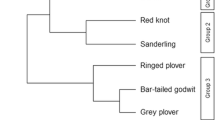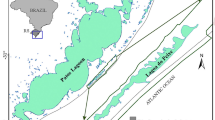Abstract
To elucidate the effects of light, site, temperature, time after emersion, and wind speed on foraging attempt rate (FAR) (attempts/unit time) and feeding success (FS) (captures/attempts) in the obligate visual foraging shorebird, Kentish plovers Charadrius alexandrinus, field observations were performed at a sandflat in Tokyo Bay, using a visible-light telescope camcorder during the day and a thermal infrared telescope camcorder at night. The re-analysis capability and frame-step replay of highly magnified video-images can contribute to accurate measurement of feeding behaviour over conventional focal observation techniques. Kentish plovers increased both FAR and FS in areas of high prey (polychaetes and crabs) density, resulting in a synergistic increase in feeding rate (captures/unit time). In areas of high prey abundance, FAR was higher at lower wind speed. FS increased with increasing time after emersion. Increasing temperatures induced a positive effect on FAR but a negative effect on FS. The effect of light on FAR was not observed; however, time-to-defecation occurrence was 2.2-fold shorter at night than during the day, indicating that feeding rate and FS are higher at night. These results are attributable to an increase in availability of cues due to higher nocturnal activity in polychaetes. Since available foraging time (emersion time) at night was 1.7-fold longer than during the day in the present study period, Kentish plovers could capture 3.7-fold (2.2 × 1.7) more prey at night than during the day. Results from this study indicate that nocturnal feeding in overwintering plovers is not a compensation but a major foraging activity to meet their energy requirements.







Similar content being viewed by others
References
Baker MC (1974) Foraging behavior of black-bellied plovers (Pluvialis squatarola). Ecology 55:162–167
Backwell PRY, O’hara PD, Christy JH (1998) Prey availability and selective foraging in shorebirds. Anim Behav 55:1659–1667
Burnham KP, Anderson DR (2002) Model selection and multimodel inference: a practical information-theoretic approach. Springer, Berlin Heidelberg New York
Crawley MJ (2005) Statistics: an introduction using R. Wiley, West Sussex
Davenport AG (1961) The spectrum of horizontal gustiness near the ground in high winds. Quart J R Meteorol Soc 87:194–221
Deschênes J, Desrosiers G, Ferron J, Cloutier R, Stora G (2005) Environmental influence on activity levels and behavioural allocation in the polychaete Nereis virens (Sars). J Exp Mar Biol Ecol 317:203–212
Dierschke V, Kube J, Rippe H (1999) Feeding ecology of dunlins Calidris alpina staging in the southern Baltic Sea, 2. Spatial and temporal variations in the harvestable fraction of their favourite prey Hediste diversicolor. J Sea Res 42:65–82
Elner RW, Beninger PG, Jackson DL, Potter TM (2005) Evidence of a new feeding mode in western sandpiper (Calidris mauri) and dunlin (Calidris alpina) based on bill and tongue morphology and untrastructure. Mar Biol 146:1223–1234
Esselink P, Zwarts L (1989) Seasonal trend in burrow depth and tidal variation in feeding activity of Nereis diversicolor. Mar Ecol Prog Ser 56:243–254
Evans PR (1979) Adaptations shown by foraging shorebirds to cyclical variations in the activity and availability of their intertidal invertebrate prey. In: Naylor E, Hartnoll RG (eds) Cyclic phenomena in marine plants and animals. Pergamon, Oxford pp 357–366
Gherardi F, Russo S (2001) Burrowing activity in the sand-bubbler crab, Dotilla fenestrata (Crustacea, Ocypodidae), inhabiting a mangrove swamp in Kenya. J Zool 253:211–223
Goss-Custard JD (1970) The responses of redshank (Tringa totanus (L.)) to spatial variations in the density of their prey. J Anim Ecol 39:91–113
Goss-Custard JD (1977) The energetics of prey selection by redshank, Tringa totanus (L.), in relation to prey density. J Anim Ecol 46:1–19
Goss-Custard JD, Durell SEALVD (1987) Age-related effects in oystercatchers, Haematopus ostralegus, feeding on mussels, Mytilus edulis. III. The effect of interference on overall intake rate. J Anim Ecol 56:549–558
Hugie DM (2004) A waiting game between the black-bellied plover and its fiddler crab prey. Anim Behav 67:823–831
Hurvich CM, Tsai CL (1989) Regression and time series model selection in small samples. Biometrika 76:297–307
Kalejta B, Hockey PAR (1994) Distribution of shorebirds at the Berg River estuary, South Africa, in relation to foraging mode, food supply and environmental features. Ibis 136:233–239
Kuwahara K (1996) Foraging behavior of Black-bellied Plover: Yatsu tidal flat, Chiba prefecture, central Japan. Bull Abiko City Mus Birds 5:125–140
Kuwae T, Kibe E, Nakamura Y (2003) Effect of emersion and immersion on the porewater nutrient dynamics of an intertidal sandflat in Tokyo Bay. Estuar Coast Shelf Sci 57:929–940
Last KS, Olive PJW (1999) Photoperiodic control of growth and segment proliferation by Nereis (Neanthes) virens in relation to state of maturity and season. Mar Biol 134:191–199
Last KS, Olive PJW (2004) Interaction between photoperiod and an endogenous seasonal factor in influencing the diel locomotor activity of the benthic polychaete Nereis virens Sars. Biol Bull 206:103–112
Lourenço PM, Granadeiro JP, Palmeirim JM (2005) Importance of drainage channels for waders foraging on tidal flats: relevance for the management of estuarine wetlands. J Appl Ecol 42:477–486
McNeil R, Drapeau P, Goss-Custard JD (1992) The occurrence and adaptive significance of nocturnal habits in waterfowl. Biol Rev 67:381–419
Mercier FM, Gaskin DE (1985) Feeding ecology of migrating Red-necked Phalaropes (Phalaropus lobatus) in the Quoddy region, New Brunswick, Canada. Can J Zool 63:1062–1067
Mouritsen KN (1994) Day and night feeding in Dunlins Calidris alpina: choice of habitat, foraging technique and prey. J Avian Biol 25:55–62
Pienkowski MW (1983a) Changes in the foraging pattern of plovers in relation to environmental factors. Anim Behav 31:244–264
Pienkowski MW (1983b) The effects of environmental conditions on feeding rates and prey-selection of shore plovers. Ornis Scand 14:227–238
Pienkowski MW (1983c) Surface activity of some intertidal invertebrates in relation to temperature and the foraging behaviour of their shorebird predators. Mar Ecol Prog Ser 11:141–150
Piersma T (1987) Production by intertidal benthic animals and limits to their predation by shorebirds: a heuristic model. Mar Ecol Prog Ser 38:187–196
R Development Core Team (2005) R: a language and environment for statistical computing. R Foundation for Statistical Computing, Vienna, Austria. ISBN 3-900051-07-0, URL http://www.R-project.org.
Robert M, McNeil R (1989) Comparative day and night feeding strategies of shorebird species in a tropical environment. Ibis 131:69–79
Rojas de Azuaje LM, Tai S, McNeil R (1993) Comparison of rod/cone ratio in three species of shorebirds having different nocturnal foraging strategies. Auk 110:141–145
Rojas de Azuaje LM, McNeil R, Cabana T, Lachapelle P (1999) Diurnal and nocturnal visual capabilities in shorebirds as a function of their feeding strategies. Brain Behav Evol 53:29–43
Rubega MA, Obst BS (1993) Surface-tension feeding in phalaropes: discovery of a novel feeding mechanism. Auk 110:169–178
Sutherland TF, Shepherd PCF, Elner RW (2000) Predation on meiofaunal and macrofaunal invertebrates by western sandpipers (Calidris mauri): evidence for dual foraging modes. Mar Biol 137:983–993
Thomas RJ, Székely T, Powell RF, Cuthill IC (2006) Eye size, foraging methods and the timing of foraging in shorebirds. Funct Ecol 20:157–165
Turpie JK, Hockey PAR (1993) Comparative diurnal and nocturnal foraging behaviour and energy intake of premigratory Grey Plovers Pluvialis squatarola and Whimbrels Numenius phaeopus in South Africa. Ibis 135:156–165
Wilson WH Jr (1990) Relationship between prey abundance and foraging site selection by Semipalmated Sandpipers on a Bay of Fundy mudflat. J Field Ornithol 61:9–19
Ydenberg R, Hurd P (1998) Simple models of feeding with time and energy constraints. Behav Ecol 9:49–53
Yokoyama H (1988) Effects of temperature on the feeding activity and growth rate of the spionid polychaete Paraprionospio sp. (form A). J Exp Mar Biol Ecol 123:41–60
Yoshiyasu K, Ozaki K (2002) Seasonal changes in numbers and diet of Kentish Plover Charadrius alexandrinus at Obitsu estuary in Tokyo Bay. J Yamashina Inst Ornithol 34:126–135
Zharikov Y, Skilleter GA (2003) Depletion of benthic invertebrates by bar-tailed godwits Limosa lapponica in a subtropical estuary. Mar Ecol Prog Ser 254:151–162
Zwarts L, Dirksen S (1990) Digestive bottleneck limits the increase in food intake of Whimbrels preparing for spring migration from the Banc d’Arguin, Mauritania. Ardea 78:257–278
Zwarts L, Blomert AM, Ens BJ, Hupkes R, van Spanje TM (1990) Why do waders reach high feeding densities on the intertidal flats of the Banc d’Arguin, Mauritania? Ardea 78:39–52
Acknowledgments
I thank E. Miyoshi for help during fieldwork, A. Kuwae and N. Oura for assistance on video image analysis, S. Harada and O. Masuko for video system information, and H. Shimura and K. Ozaki for shorebird information at the site. I also thank R. W. Elner, R. C. Ydenberg, K. J. Mathot, A. C. Pomeroy, and R. W. Butler for valuable comments. The manuscript was greatly improved by the valuable comments of three anonymous reviewers. This research was supported by grants to T.K. from the Port and Airport Research Institute Exploratory Research and the Japan Society for the Promotion of Science (JSPS) Postdoctoral Fellowships for Research Abroad (FY2004).
Author information
Authors and Affiliations
Corresponding author
Additional information
Communicated by S. Nishida, Tokyo.
An erratum to this article can be found at http://dx.doi.org/10.1007/s00227-006-0590-z
Rights and permissions
About this article
Cite this article
Kuwae, T. Diurnal and nocturnal feeding rate in Kentish plovers Charadrius alexandrinus on an intertidal flat as recorded by telescopic video systems. Mar Biol 151, 663–673 (2007). https://doi.org/10.1007/s00227-006-0506-y
Received:
Accepted:
Published:
Issue Date:
DOI: https://doi.org/10.1007/s00227-006-0506-y




